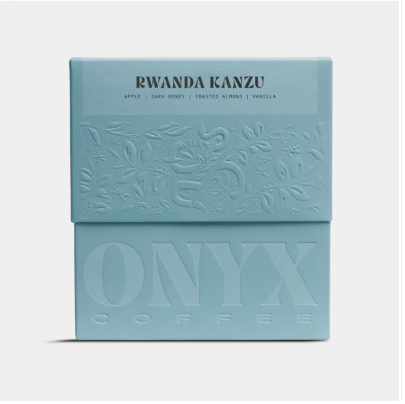
About this Coffee
In the tropical volcanic soil of Rwanda just west of the famed Lake Kivu, lies the Kanzu coffee station that mills this group of smallholders farmers coffees. This offering showcases a rich sweetness tasting of different caramelization levels of complex sugars and crisp apple. Celebrate Rwanda’s best cups with this Kanzu! It’s time to consider Rwanda a dominate growing origin for the foreseeable future.
Located just west of Lake Kivu’s blue-green (and deadly) waters, the Kanzu station is set against verdant green hills where coffee, sugar cane, and bananas are grown. There is a fertile crown of land around the ancient volcanoes where ash has collected and caused the soil to be rich in minerals. Smallholder producers grow small amounts of bourbon variety coffee alongside sustenance crops of bananas and beans. The Kanzu station begins collecting cherries in March, and harvest stretches all the way to July. Thanks to stellar management and harvest planning, the Kanzu station separates the harvest into outturns. (much like Kenya) Cherries that arrive at the washing station are floated to separate the less dense cherries away, just as an initial quality check before fermentation. A Mckinnnon disc pulper then strips away the outer skin of the cherry, leaving a mucilage-covered seed that undergoes a dry fermentation for up to 18 hours. The wastewater is then treated with Effective microorganisms (EMTechnologiesTM) to ensure runoff and erosion are managed, securing precious water resources for the surrounding community. The community surrounding the Kanzu station has been the subject of focused aid efforts since the mid-’90’s which has transformed the Rwandese coffee industry following the end of the genocide. Much of this has been due to USAID and Dr. Tim Schilling, who has led the effort to build collection stations and developed cooperatives. This work has led to the burgeoning market access that specialty coffee grown in Rwanda has experienced over the decade.
WASHED PROCESSED COFFEES
The washed process begins with coffee cherries delivered to the washing station, both from the primary market or from farmers bringing their coffee directly to the mill. The cherries are inspected, and an initial quick round of hand-sorting separates the defective coffees before placing them into the hopper. They are then funneled to the depulper, which removes the fruit from the seeds (beans). After that phase is done, the coffee is fermented underwater for approximately 12-36 hours. During this fermentation, a microbial de-mucilagation takes place, which allows the outer fruit and pectin layer to break down, making the coffee easier to dry. This phase also crucially alters the organic acids within the coffee, as sugars and organic acids are transformed, with the best washed coffees maintaining their complex fruit esters. Once the fermentation is complete, the parchment is emptied into the washing channels, where it is agitated with rakes to remove the last of the fruit layer. During this step, the water is refreshed to ensure its capability of separating the fruit layer from the seed. Once the washing is complete, the coffee is taken to the raised drying tables for sun drying